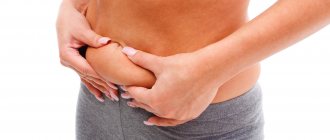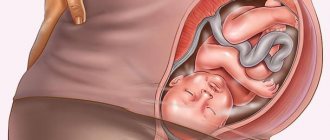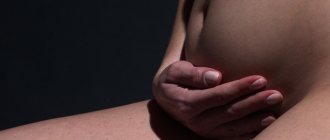03/28/2018 Category: Recovery after childbirth Author: Ekaterina Pavlish
Pregnancy and childbirth are, of course, a huge burden on a woman’s body. The most serious metamorphoses occur with the uterus. By the end of pregnancy, the volume of its cavity increases almost 500 times, and its weight increases by 10–20 times. After childbirth, the surface of the uterus is, in fact, a continuous wound, the damage is especially severe at the placenta attachment site. Contraction (or involution) of the uterus begins immediately after childbirth: at this time, the uterus is cleared of residual blood and fetal membranes, open blood vessels are compressed and dry out, the epithelium is restored, and the uterus gradually returns to its prenatal size. Typically this takes 6 to 8 weeks. But this process may be delayed, for example, due to the advanced age of the woman in labor, during multiple pregnancies, etc. In women who give birth by cesarean section, uterine involution also occurs more slowly than in women who give birth vaginally. In this case, along with medications and massage, doctors recommend that women do special exercises.
- Exercises to contract the uterus after childbirth in the first days
Gymnastics after childbirth - video
- Main complex
How the uterus contracts
- Immediately after childbirth, one can only feel sorry for the uterus - this is complete damage. Particularly affected was the placenta attachment site. The poor organ is filled with blood clots, remnants of the fetal membrane, and the entire organ is “tuned” not to beauty, but to rapid healing.
- In the first 3-5 days after the baby appears, the uterus cleanses itself, contracting especially powerfully. Yes, yes, it’s not for nothing that you took such a large pack of night pads to the maternity hospital!
- Phagocytosis (bacteria are dissolved by white blood cells) and extracellular proteliosis occur in your body. Of course, provided that you are healthy.
- Lochia (discharge from the mother who gave birth) comes out of the uterus. On the first day they are bloody, on the third they are brown, in the third week they seem to lighten, and by the sixth they are almost gone. This ends the cycle of uterine contractions.
- The uterus of a woman who has just given birth weighs about 1000 g. Its dimensions are: 20 cm in length, 15 cm in width, 12 cm in the pharynx. Only 7 days will pass, and the weight of the organ will be reduced to 300 g, and after 2.5 months the uterus will weigh only 70 g!
The uterine epithelium heals quickly – about 20 days, but the placenta “attachment” site takes longer – up to 45 days. The doctor will probably ask you to listen to your contractions. If the discharge ends around the sixth week and you feel well, there is no reason to complain to the gynecologist. If they ended much earlier or, on the contrary, were delayed for a long time, it is better to go to the doctor.
Features of exercises for stitches in the intimate area
The presence of stitches after ruptures of intimate organs is a categorical contraindication for physical activity. After an episiotomy, a woman should be extremely careful when making any movements. Do not sit in a sitting position for the first week or two after surgery. Otherwise, you can provoke pain in the suture area.
Physical activity is allowed only after complete healing of the tissues of the intimate organs. Approximately 2-3 months after delivery you should visit a gynecologist. During the examination, the doctor will decide whether to perform physical exercises.
Symptoms of healthy uterine contractions:
- unpleasant, but generally tolerable sensations in the mammary glands,
- pain in the perineum,
- discomfort in the lower abdomen,
- discharge - lochia,
- diarrhea (the first few days; after the 4th day, this symptom may indicate an overdose of the drug and should be the reason for going to the hospital).
Any of these symptoms may be severe during the first 7 days after birth. At the end of the 6th week of your motherhood they should stop.
Most often, young mothers suffer from pain and illness. However, if you have a low pain threshold, consult a doctor - he will prescribe a pain reliever: ibuprofen, no-shpu, naproxen, ketoprofen (or ketanol suppositories), a lidocaine injection, or something from hemeopathy - sepia, caulophyllum, bellis perennis.
Eight days have passed since giving birth, and you still have to take pills? This is not normal, go to a gynecologist and have him check you for pathology.
Rapid contraction of the uterus
It happens that pain and discharge disappear already 3-4 weeks after childbirth, and the woman is very happy with this. However, this is not a very good sign. Rapid contraction of the uterus can have the following complications:
- some of the lochia did not come out, lingering inside the organ, which is fraught with suppuration and inflammation (do not forget that these are nothing more than bloody clots, remnants of the placenta and endometrium, and even waste products of your baby),
- problems with lactation: accelerated contractions of the uterus can “cut” the amount of milk produced by the body, as well as change its composition, which is why the baby may even refuse his mother’s boobs,
- the risk of getting pregnant again increases, and this would be a shock for your body, since the uterus has not yet recovered.
In general, if you notice that there is no discharge too early, do not think about returning to your sex life (no matter how much you and your husband would like it), but about consulting a gynecologist.
Well, to prevent such “accelerations” from happening, increase uterine contractions. This is not difficult: follow a daily routine (if you can, ask older children, mother, mother-in-law, sister to help with the child), eat normally, get enough sleep (let the new dad “serve” the night watch for at least a couple of weeks), walk in the fresh air. In general, you don’t need any pills or “herbs”.
Possible problems
Some women in labor ignore doctor's recommendations to undergo a preventive examination during the postpartum period. A negligent attitude towards your health can lead to various complications. The most common complication of this period is subinvolution of the uterine organ. In addition, a woman may experience inflammation of the reproductive organs of an infectious nature and disruption of their functions.
Slow contraction of the uterus leads to retention of lochia in its cavity. The pathology is dangerous because the organic components contained in the secretions can become an ideal environment for the proliferation of pathogenic bacteria.
Preventing any disease is easier than treating it. The main measures to prevent possible complications of the postpartum period are:
- compliance with personal hygiene rules;
- preventing the accumulation of secretions in the uterine cavity;
- regular visits to the gynecologist;
- gymnastics after childbirth.
After discharge from the maternity hospital, the woman in labor should closely monitor the condition of her body and the amount of discharge that comes out of the vagina. If you feel unwell, you should immediately consult a qualified doctor.
Recommended entries:
You need to be logged in to leave a comment.
Too slow uterine contraction
If accelerated contraction of this organ is rare, then protracted contraction is, unfortunately, a frequent visitor to young mothers. How to speed up the renewal of the uterus and quickly restore your body? Everything is elementary. First, consult a doctor to rule out pathologies. Secondly, don’t be lazy - a specialist will probably recommend exercises, as well as herbs.
How can official medicine help you?
If immediately after childbirth (the first to third day) you do not develop lochia and there are no unpleasant contraction-like sensations in the lower abdomen, then for some reason the uterus is not contracting. The doctor should decide her fate: only he knows what will help you better, pills or injections.
Oxytocin
This artificial hormone will help normalize lactation, heavy bleeding, and also speed up uterine renewal. It is often prescribed in the form of injections, and in particularly difficult cases (for example, after a cesarean section) - in the form of droppers.
Uterine oxytocics
Drugs from the same group, but with pharmacological additives that enhance or weaken the effect of the central substance. These are: hyfotocin, dinoprostone, ergotal, pituitrin. Prescribed both in tablets and injections.
It is important to remember: although official medicine recognizes oxytocin, some doctors do not approve of it, believing that uterine contractions should start naturally. Such a specialist will first of all advise you to turn to traditional medicine.
"Grandma's" medicines
Although these are harmless “herbs” at first glance, you should not prescribe them to yourself (or trust your mother or neighbor to prescribe them). Any treatment, even folk treatment, must be approved, or even better, prescribed by a doctor.
White lily
Pour 2 tablespoons of dried flowers into 0.5 liters of boiled cold water. Let stand overnight. Drink 100 ml 3-4 times a day.
Nettle
Pour 4 tablespoons of the dry plant into 500 ml of boiling water, let the broth cool. Drink 100 ml 3 times a day.
Shepherd's Purse
Pour 4 tablespoons of herbs into 2 cups of boiling water. Wrap until cool. Drink this amount of decoction all day.
Blood red geranium
Pour 2 teaspoons into 1 glass of cooled boiled water overnight. Drink all day.
Yarutka field
Pour 2 tablespoons of the plant into 1 glass of boiling water overnight. Drink 1 teaspoon 5 times a day.
These remedies are good because they help your body “start up” after childbirth without medications. After all, what kind of nursing mother wants something pharmaceutical to get into her precious milk!
Massages
Sometimes in the maternity hospital the doctor may do special stimulating strokes on the mother’s belly. Their goal is to stimulate the uterus. They are done every 2 hours. The doctor gently presses on the uterus. Of course, this procedure can be unpleasant, but it is worth enduring, as it is very useful.
Will homeopathy help?
Many mothers in labor like “sweet white granules” primarily not because of their pleasant taste, but because they do not contain chemicals or synthetic substances, effectively helping the uterus contract, and also mobilizing all the body’s forces for postpartum recovery.
The most popular remedies for women in labor include: quinine (helps with heavy bleeding), ipecac (eliminates weakness), staphysagria (heals the uterus from the inside), and ergot (contracts the uterus - but you need to be careful with this remedy, it can cause thrombosis and abscess ).
What else you should know
If the uterus does not contract after childbirth, doctors will tell you what to do, but a lot depends on the young mother herself. Its reduction is stimulated by physical activity and breastfeeding. When a baby is regularly applied to the breast, the hormones prolactin and oxytocin are produced; the higher the hormonal activity, the better the uterus contracts.
Mothers themselves can even feel the effect of these hormones: while feeding the baby, contractions are felt in the uterus, which are often called postpartum. Similar sensations can be felt if you lie on your stomach. This also helps the uterus contract, especially if you lie down with a small bolster or pillow under your stomach.
The pain of contractions during uterine contractions is incommensurate with real contractions during childbirth, which is why they are easily tolerated without pain relief. For severe complaints, it is possible to use antispasmodics, but the decision on the need for their use must be made by a doctor. You should not postpone exercises for contracting the uterus after childbirth because they cause discomfort. The faster the uterus contracts, the sooner you can forget about the pain.
Exercises to contract the uterus
If the doctor gives the go-ahead, then even from the first day after birth you can start doing simple but very useful exercises that will help the uterus contract correctly. Such activities do not require much time, but the sooner you start doing them, the faster the uterus will recover and contract, and the lower the risk of long-term recovery after childbirth.
- Lie on the floor on your back. You can use a soft mat to make it more comfortable. bring your legs together and relax. Alternately bend and straighten your legs at a calm pace. 10-12 times on each leg will be enough.
- Also lying on your back, straighten your legs and stretch your toes towards you.
- Periodically curl and relax your toes.
- Special breathing exercises have a good positive effect. And again you need to lie down on the floor, bend your knees. Breathing is smooth and deep. As you breathe, lift your abdominal wall as you inhale and lower it as you exhale. You can help yourself with your hands, making sliding movements towards the pubic bone from the navel.
- As you exhale, squeezing your pelvic muscles, pull your navel as close to your chest as possible and hold your breath for 10-15 seconds. This exercise is called “Vacuum”.
- Kegel exercises will be indispensable in such gymnastics.
- Take a fitball or exercise ball and find a non-slippery surface. Sit on the fitball, squeeze your intimate muscles and, without relaxing them, lift your legs one by one, holding it on the weight for 10-15 seconds.
- Sitting on a fitball, perform circular movements with your pelvis in both directions. You can also swing in different directions.
This is some gymnastics for contracting the uterus. However, these exercises are contraindicated after suturing, as you will first need to wait until they are completely healed.
Physiology of the postpartum period
During the period of involution, the vagina returns to its previous parameters. This occurs within three months after delivery. Exercises to contract the uterus, massage and breastfeeding help to recover after childbirth.
The uterus quickly returns to its previous parameters, but the labia remain wider than they were and change their color to a darker one.
Also, after the birth of a child, women in labor may experience a rise in body temperature, chills, and a decrease in blood pressure. A lady may feel a rise or loss of strength, emptiness, depression, fatigue, and rapid mood swings. During this period, women especially need support and help.
To restore the body faster, many women resort to traditional medicine, take vitamins, medications (if prescribed by a doctor), and also perform exercises to contract the uterus after childbirth.









